Yoga and high-intensity interval training are at essentially opposite ends of the movement spectrum. HIIT, while sometimes community-oriented, is competitive, often requiring the exerciser to push beyond his or her body’s limits, which can result in injury. Yoga, conversely, asks us to listen to our bodies and honor where we are at that moment, including our limitations.
Still, people get injured in yoga, even seasoned yogis. However, the practice is about developing a deep awareness of self and going against our Western tendency to push ourselves over the edge.
For a richer perspective, I asked for input from a fellow yoga teacher who works with HIIT athletes. I also asked a student of mine who regularly does HIIT to share her experience. Here’s what they told me:
Tod Ceruti, the yoga teacher, said when he teaches yoga to HIIT athletes, he finds the majority of his students don’t have keen body awareness, and they don’t know how to use their breath to help calm their bodies and minds. And they are very tight, especially in their hips.
Ceruti uses the idea of yoga as an opportunity for healing. “Yoga builds strength and flexibility, and [assists with] recovery, which is key,” he says. “If you’re going to push your body, you need recovery.”
He tells his students that yoga will make them better athletes if they practice a few times a week. “They are strong, but they are missing so much,” Ceruti says.
Cara Hawkins has been coming to my yoga class for about six months, and she’s been doing a well-known form of HIIT since 2012. She is strong and muscular, and she said she loves her fitness community, which helps push her to do more than she thought she could. “I learned how strong and disciplined I can be,” she says.
Through yoga, she is learning about her body and how it works. “I have never taken the time to be this body conscious and have gratitude for it,” Hawkins explains.
Yoga has also encouraged Hawkins to care for her body during a HIIT workout. “The way I breathe and move through my workouts is different,” she says. “My mental focus is better. I’m able to gain strength through my breath.”
Hawkins said she feels the two practices are engaged in a tug-of-war. “Yoga is about the process more than the end result, whereas the HIIT is the opposite.”
In the end, it’s all about balance, right?
Here are five yoga poses HIIT athletes can incorporate into their routines to help build flexibility, strength, focus and confidence.
Warrior II (Virabhadrasana II)

This pose works on leg, ankle, shoulder and back strength, while stretching the hips and inner thighs. Warrior II requires deep focus and attention to your breath.
From standing, step back with your left foot into a wide stance and turn your left foot in about 45 degrees. Open your arms so your right arm stretches forward in line with your right toes and your left arm stretches behind you. Bend your right knee to lower your hips. Keep your back leg firm and your back straight. Reach through your fingertips to opposite walls. Hold for three to five breaths and repeat on the other side.
Wide-legged Forward Fold (Prasarita Padottanasana)

This pose stretches the back side of the body while releasing tension in the shoulders and neck.
From Warrior II, bring both feet parallel to the short edges of your mat. Inhale and stretch your arms overhead. Exhale and swan dive into a forward fold. If your hands do not touch the floor use a yoga block for support. To deepen the pose, shift your weight into the center of your feet, lift your kneecaps and release the crown of your head toward the floor.
Variation 1—Eagle Arms
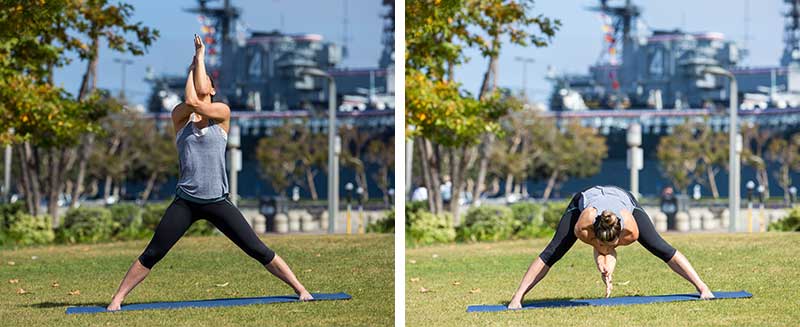
For an additional shoulder and upper-back stretch, start standing and bring your left arm under your right so the elbows are hooked. Slide your left palm up your right palm (or grab hold of your shoulders if your hands don’t touch). Inhale and lift your elbows. Exhale and fold forward, drawing your elbows toward your belly button. Hold for five breaths and then switch arms.
Variation 2—Twist
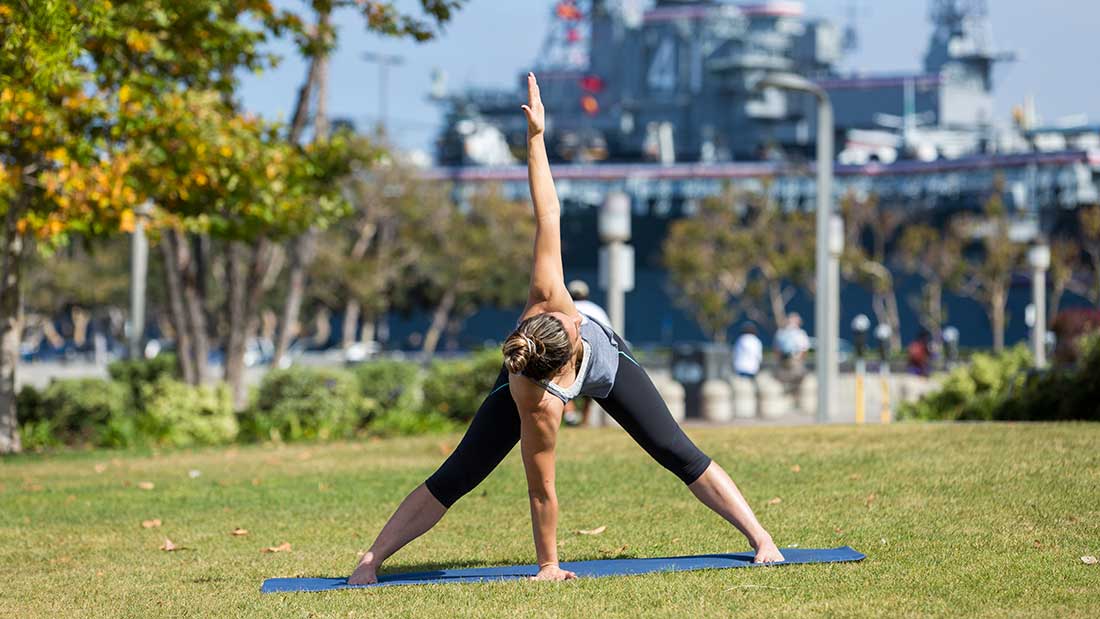
From the fold, place your left hand directly underneath your head on the floor or a block. Inhale and lift your right arm toward the ceiling. Maintain awareness of the flatness of your hips, trying to keep your right hip from reaching up or back. Maintain strong legs and breathe for three to five rounds of breath and then switch sides.
Tree Pose (Vriksasana)
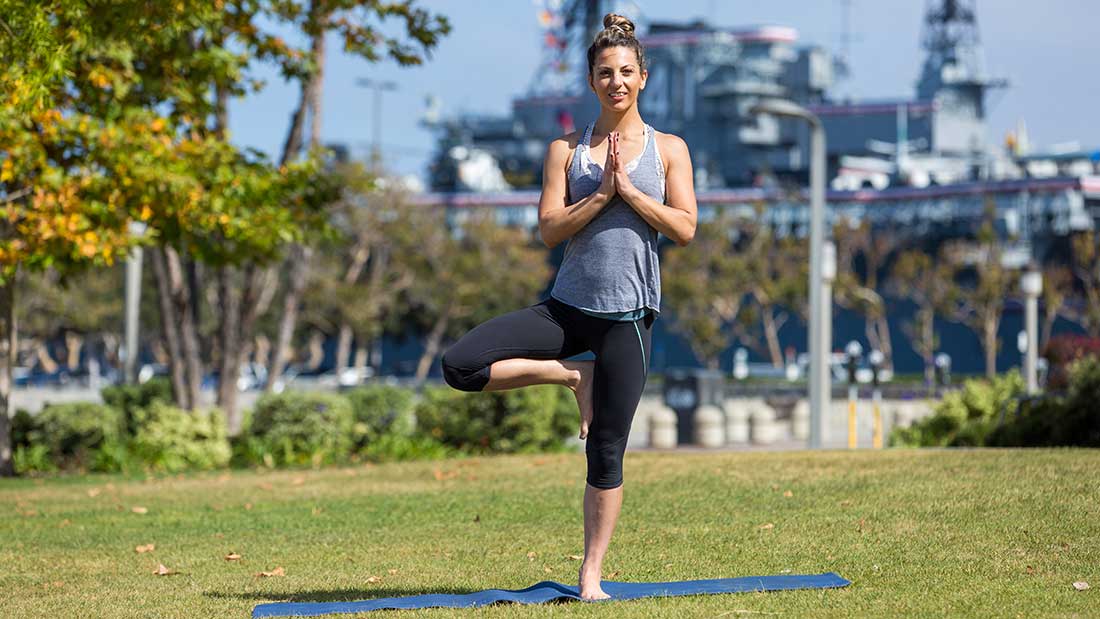
This is a simple, yet challenging pose to work on core stability, balance and strength, while also opening the hips and chest.
Standing tall with the thighs and abs engaged, shift your weight to the left leg and bring your right foot into the side of your left ankle, shin or inner thigh (avoid the knee joint). Bring your hands to your heart center and gradually lift them overhead as branches growing toward the sun. Keep your left thigh engaged and lift out of your left hip. Relax your shoulders, staying tall and uplifted. Hold for three to five breaths and then switch legs.
Bridge Pose (Setu Bandha Sarvangasana)

This pose will open the front of your hips and chest, while also strengthening the legs, glutes and back.
Lie down on your back with your feet on the floor and the knees bent. Stretch your fingertips toward your heels and take your gaze toward your knees. Inhale and begin to lift your hips one vertebra at a time, while keeping your shoulders rooted into the floor. Lift your chest as you exhale. Hold for three to five breaths. Roll down to your back one vertebra at a time. Repeat one to two more times.
Variation—Restorative Bridge

For a more restful opening of the front side of the body, place a block, bolster or firm pillow beneath your sacrum (the flat part of your lower back) to elevate your hips. Keep your knees aligned with your ankles. Relax your shoulders and close your eyes. The height of your hips will vary with your level of flexibility, but it should feel comfortable to hold for at least one minute. Hold up to five minutes.
Pigeon Pose (Eka Pada Rajakapotasana)
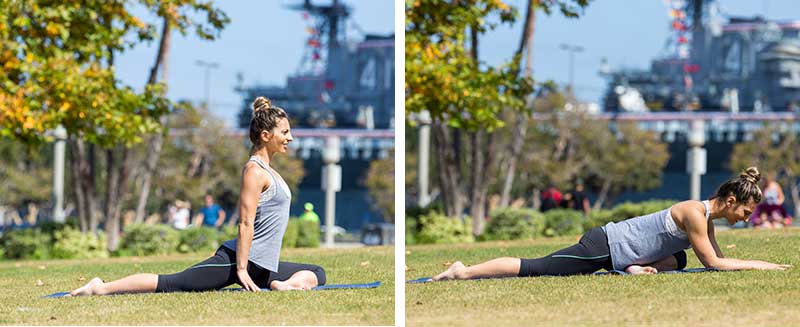
One of the most sought-after stretches after a work out, pigeon is great for stretching the psoas and piriformis muscles. If you have tight hips, place a blanket under your hips for support. From a seated position, bring your left shin parallel with the top edge of your mat. Roll toward your left leg to lift your hips off the floor. Extend your right leg, so your toes reach toward the back of your mat. Make sure your hips are even and supported either by a blanket or the floor. Fold forward and release into the mat. Hold for five to 10 breaths and then switch sides.
Variation—Reclined Pigeon
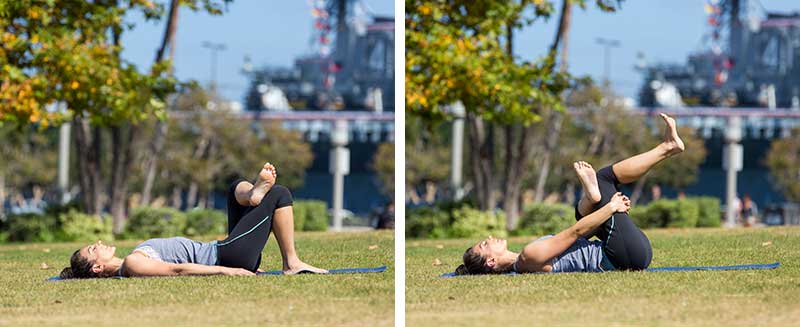
If your knees are sensitive or your hips are really tight, a nice option is to lie down on your back with both feet on the floor and the knees bent. Cross the left ankle over the right thigh, flexing your left foot. Stay here, or for a deeper stretch, grab the back of your right thigh and draw it in toward your chest, maintaining a connection with the floor through your whole spine. Hold for five to 10 breaths and then switch sides.
Shoshana Hebshi Contributor
Shoshana Hebshi is a freelance writer and editor living in Northern California where she practices and teaches yoga. She is a RYT-200 with a focus on teaching yoga for athletes, prenatal yoga and vinyasa yoga. She has a master's degree in journalism and mass communication from Iowa State University, and an undergraduate degree in journalism from Cal Poly, San Luis Obispo. Find her on Instagram @NorCalYogi and Twitter@ShoshanaHebshi.






